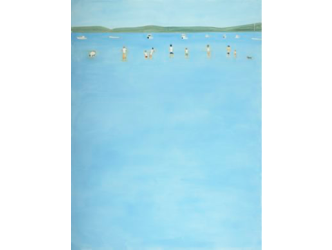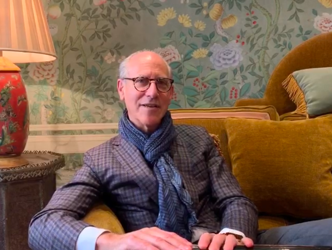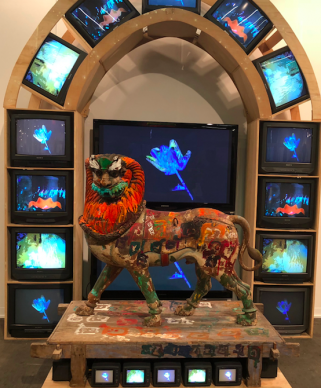The same painting
Across kilometres and kilometres, since the very beginning, or almost, Anselm Kiefer (born in 1945) has been making the same painting. This is not to say that he’s repeating himself, that the theme or composition are identical.
In France since 1992
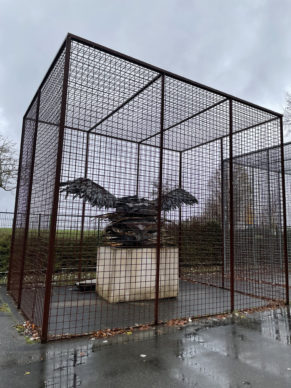
It’s more the fact that the German artist who lives in France since 1992 has been expressing himself over the long term. His gestures have been guided by the same obsessions. A unity of inspiration for a multiplicity of places.
First he reads

Anselm Kiefer ‘s studio
Whether he’s staying at his huge property in Barjac, Provence, at his home in the Marais in Paris, or in Croissy near the capital, which is where he is currently based, at his gigantic warehouses (60 000m2) converted into working and living spaces, the principle is the following: first thing each morning he reads, early, preferably poetry. On that particular day, he picked out a book by Cioran from his vast library. When the seed of a painting is planted, Kiefer experiences what he calls a jolt, and this becomes the concept: it might be a landscape, a poem…
While sailing

“That one came after I’d been sailing,” he says, pointing to a dark and dense mountain with a sun hanging overhead against a black sky. His journal, which he uses often, serves to clarify his visual ideas or to resolve problems relating to the artwork. Then he paints, sometimes over the top of a photo. Along with the paint itself he adds various materials, including all kinds of objects.
Words as sediments
He also sometimes writes on his paintings. “Because words form a sediment in me. They become part of my person.”
Never satisfied with himself
But invariably the first attempt won’t be right. “I am never satisfied with myself. The majority of my paintings don’t reach the level I’m hoping for,” confesses the artist.
Artworks everywhere

And so there are artworks everywhere in these spaces at Croissy, sometimes spending years awaiting an unknown fate. It’s raining hard on the roof. There’s the hum of amateur aircraft coming from the neighbouring airfield. He likes it very much, the sound of the planes. “It’s life.”
Rodin-esque spirit

There are large tables everywhere laden with very heavy books open at pages with plaster covered in watercolours showing women moving in a Rodin-esque spirit, or painted russet leaves like in a herbarium. On giant picture rails, from room to room, there are paintings waiting for perhaps the day when they will be modified, cut up, reconfigured, assembled. This will take place in line with his projects, on the occasion of an exhibition such as, for example, the one at the Pantheon (in November 2020) (See here the report about his exhibition at le Panthéon and Gagosian Le Bourget) , at the Grand Palais Ephémère (from 16 December 2021), or in April 2022 at the Palazzo Ducale in Venice.
Paul Celan

He describes the themes that live inside him and drive him to paint not as cycles but rather as spirals. The theme that consumed him in those days bears the name of a Romanian-born poet who wrote in German. Miraculously, he managed to evade the holocaust and ended his days in France: Paul Celan (1920-1970).
Grand Palais Ephémère
The exhibition at the Grand Palais Éphémère resembles a grandiose vision of the apocalypse. There can be no doubt that Kiefer is being driven by a new flame that can also be found, in a literal sense, in his paintings. The visual experience is powerful with 19 monumental canvases (up to 15 metres long) plus four sculptures.
An act of love
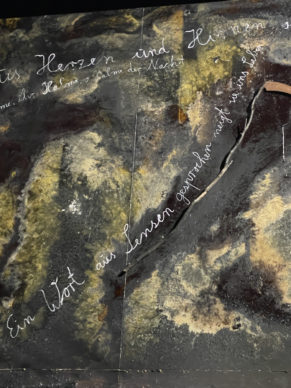
The paintings are arranged back to back in a staggered sequence in the space which now resembles an aircraft hangar. Everywhere across the compositions the artist has written in white paint, like an act of love, “fur Paul Celan”.
Pour Paul Celan
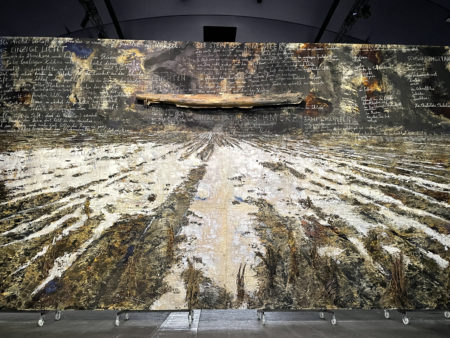
The exhibition at the Grand Palais Ephémère is quite simply called “Pour Paul Celan” (For Paul Celan). “He is always there with me, everywhere I go. I started out with him in the 1970s. I discovered him when I was 16 years old,” recalls Anselm Kiefer.
Death Fugue
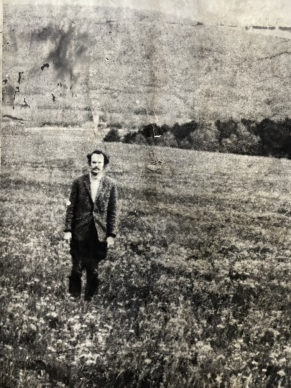
“It happened one morning. I was at school in Rasstatt (ed: Bade-Wurtenberg). We read ‘Death Fugue’ (1). It made a big impression on me. At the time, you know, I had no knowledge of the holocaust. We didn’t talk about it in Germany. I felt that there was something vast and monstrous behind it all.”
Sacred fire
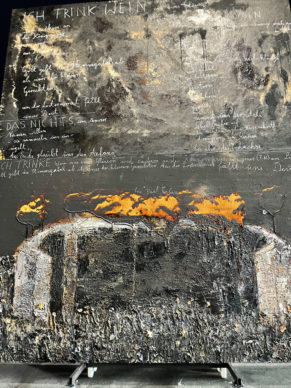
We might imagine that it was precisely during the course of that morning that Anselm Kiefer’s sacred fire was lit; the fire that would drive him to express himself, through his eternal painting, on the idea of desolation, death, the final solution, while being kept silent in Germany. Some years later the young artist, in a bid to raise awareness, would pose in different places doing the Nazi salute, making himself unpopular in his country. Today he reveals it was the Jewish American collectors who were the first to support him.
Only poetry is true

In Kiefer’s work, words and painting are not in opposition but rather in a kind of fusion. You could say that he makes poetry through painting. He observes: “Nothing around us is true, except for poetry. Celan, Rilke, Goethe… Phrases appear just like that in my head,” he says, wheeling his arms around.
Van Gogh self-portrait
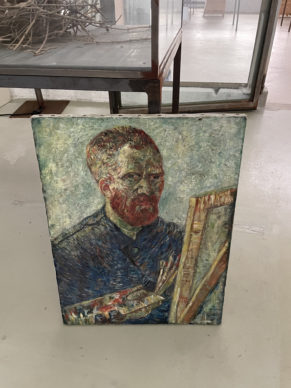
Words, yes, but there is also paint. At Croissy the vast array of shelves in his library reveal just how much the artist is immersed in art history. On the ground there is a painted copy of a self-portrait of Van Gogh which he made when he was around 14 years old. “I got it out for a conference at the Tate Gallery.”
Edvard Munch
In one aisle of the library there are taped up reproductions of works by Munch (Read here the report about the new Munch museum). “He’s another one of my favourite painters. Munch gave the landscape a feminine appearance. It’s remarkable.” In another file he highlights that the American abstract painter Willem de Kooning is capable of producing a monumental painting on small-scale canvases, measuring 1.5 metres in length. “To understand this, just look at his series from the late 1950s, the Havana paintings.”
Palazzo Ducale
When he talks about the room he’s due to paint in its entirety at the Palazzo Ducale in Venice next spring, he sees it literally as a project where he is in competition with Tintoretto. “It’s a major challenge. Yes! Of course I’m in competition with past painters,” he explains, laughing loudly.
Desolation
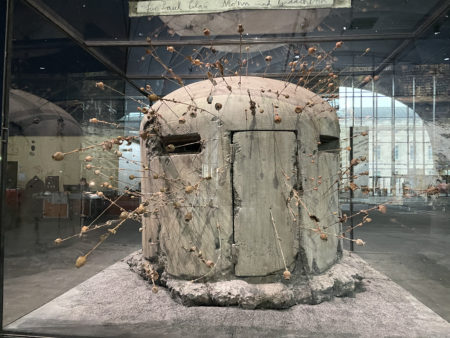
Nonetheless, his paintings express desolation. A universal desolation that we could see as a reference to the holocaust, but which is also a reference to current times.
The re-emerging of the vermin
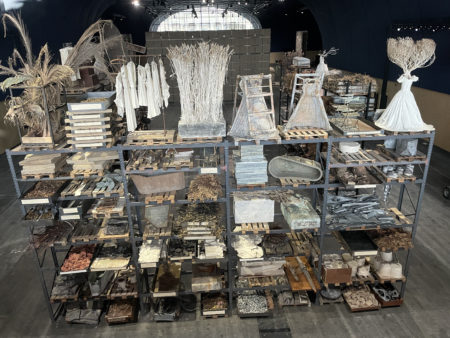
The artist, haunted by the horrors of the 20th century, is worried: “The vermin are re-emerging. You can see it. In Germany everything is hidden under the cover of democracy. It’s very dangerous.
Weakened Europe
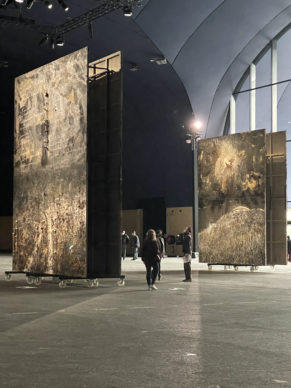
The global situation is critical,” he says, alluding to a weakened Europe caught between Europe and the USA. “Our childhoods are the source of our inspiration. As an artist, our role is to draw links between the past and the future,” he concludes.
Forever Celan

Yes, the Celan from his 16-year-old self still resides within him. His “Death Fugue”, which has lines about the “black milk of dawn”, digging “a grave in the air” and “your golden hair Margarete”, are very much present in the canvases on show at the Grand Palais Ephémère.
Dreaming of the masterpiece
And when night falls, once again Anselm Kiefer, at the age of 76, the painter who dances in front of his paintings, will dream of “his” masterpiece. “It’s always the same thing. I have a recurring dream about making THE painting, the one that will be the best, the ultimate. But I know I will never be able to do so.”

Grand Palais Ephémère
From 16 December to 11 January. Pour Paul Celan.
https://www.grandpalais.fr/fr/evenement/anselm-kiefer
(1) “Death Fugue” begins like this in English: “Black milk of morning we drink you evenings / we drink you at noon and mornings we drink you at night / we drink and we drink / A man lives in the house he plays with the snakes he writes / he writes when it darkens to Deutschland your golden hair Margarete / he writes and steps in front of his house and the stars glisten and he whistles his dogs to come / he whistles his jews to appear let a grave be dug in the earth / he commands us play up for the dance”
Donating=Supporting

Support independent news on art.
Your contribution : Make a monthly commitment to support JB Reports or a one off contribution as and when you feel like it. Choose the option that suits you best.
Need to cancel a recurring donation? Please go here.
The donation is considered to be a subscription for a fee set by the donor and for a duration also set by the donor.

